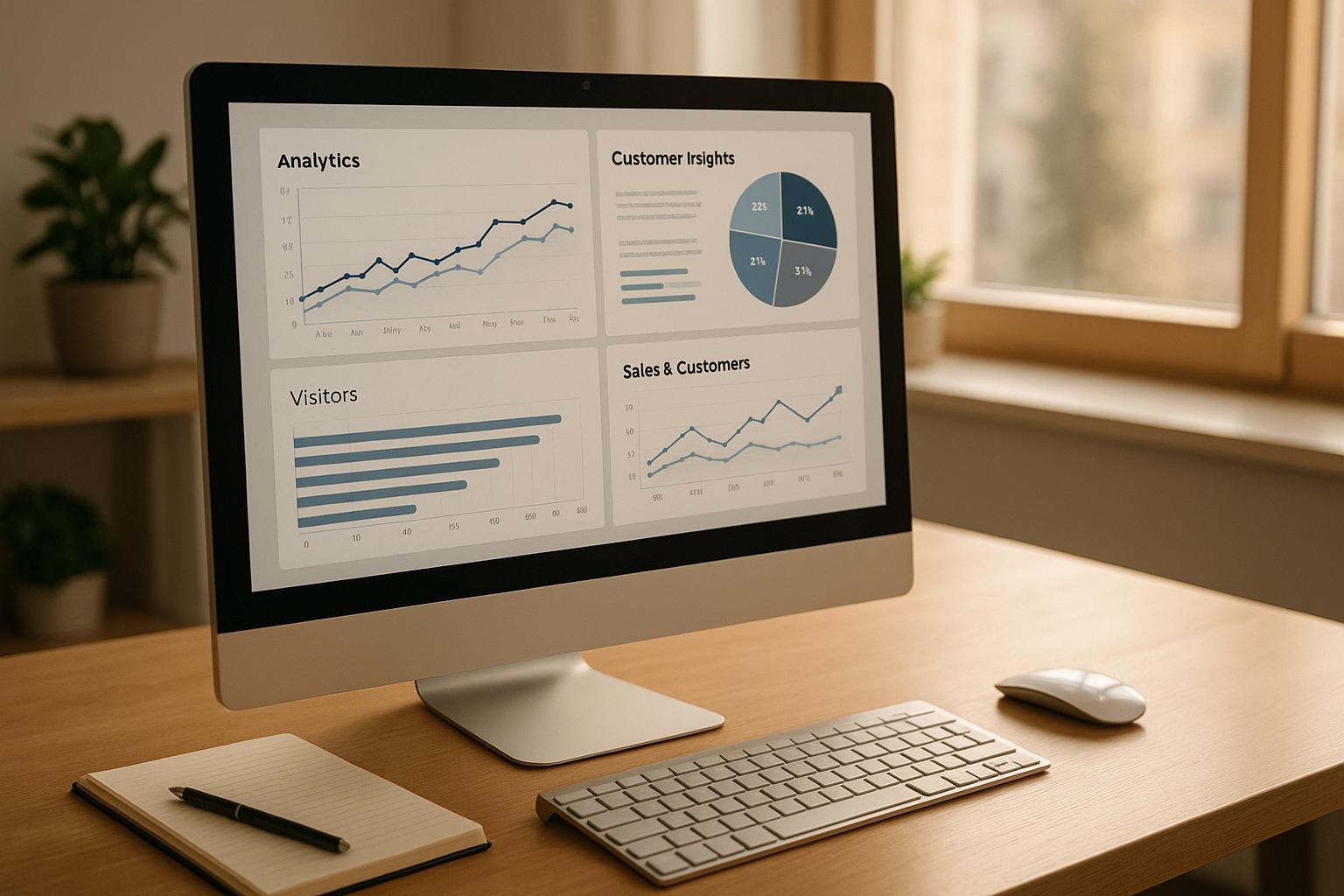Want to protect your digital assets from cyber threats? Here's how:
Cybersecurity risk assessments are essential for identifying risks, securing your systems, and ensuring smooth operations. Follow these five steps to safeguard your digital ecosystem:
-
Set Assessment Boundaries
- Identify critical systems (CMS, data storage, networks, third-party tools).
- Align with business goals and legal standards (e.g., CCPA).
-
List and Rank Key Assets
- Catalog assets (content, infrastructure, software).
- Prioritize based on business value, sensitivity, and recovery cost.
-
Spot Security Gaps
- Assess external threats (ransomware, DDoS attacks) and internal weaknesses (access control, outdated software).
- Use tools like vulnerability scans and penetration testing.
-
Measure Risk Levels
- Calculate risk scores using likelihood, impact, and asset value.
- Focus on high-priority risks that impact revenue, operations, or compliance.
-
Address Top Risks
- Implement technical controls (firewalls, encryption, MFA).
- Train staff on security best practices.
- Regularly update and monitor your protection measures.
Quick Tip: Regularly review your security plans and adapt to evolving threats to stay protected.
Conduct a Cyber Security Risk Assessment in 5 Steps
Step 1: Set Assessment Boundaries
Define clear boundaries to focus on critical systems while staying compliant with legal requirements.
Map Core Systems
Start by listing all essential systems:
- Content Management Systems (CMS): Platforms used to create, store, and share digital content.
- Data Storage Solutions: Includes both on-premises servers and cloud storage platforms.
- Network Infrastructure: Covers VPNs, firewalls, and communication tools.
- Third-party Integrations: APIs, plugins, and external services that connect to your systems.
- User Access Points: Employee devices, mobile tools, and remote access setups.
Use a network diagram to identify potential weaknesses and risks.
Align with Business and Legal Standards
Ensure boundaries comply with operational goals and regulations like the California Consumer Privacy Act (CCPA).
| Regulation | Key Requirements | Assessment Focus |
|---|---|---|
| CCPA | Data privacy and consumer rights | Systems handling user data collection and storage |
Key Areas to Address
-
Data Classification
Organize data into categories such as:
- Customer personal information
- Payment processing details
- Content assets and intellectual property
- Materials shared with partners
-
Operational Impact
Focus on systems that directly affect:
- Content delivery
- Revenue-driven processes
- Customer data handling
- Tools for partner collaboration
-
Resource Allocation
Plan for:
- Immediate assessments
- Regular monitoring
- Periodic reviews
- Emergency response protocols
Step 2: List and Rank Key Assets
After defining your boundaries, catalog essential assets to understand their risk levels.
Build Asset Inventory
Using the established boundaries, compile a list of your most important assets:
Digital Content Assets
- Content libraries and archives
- Media files (images, videos, audio)
- Research data and market insights
- Brand-related materials
Technical Infrastructure
- Production and staging servers
- Content delivery networks (CDNs)
- Development and testing environments
- Backup and disaster recovery systems
- Database management tools
Software and Applications
- Content management systems (CMS)
- Digital asset management (DAM) platforms
- Analytics tools
- Customer relationship management (CRM) software
- Collaboration tools
| Asset Category | Examples | Security Priority |
|---|---|---|
| Core Systems | CMS, DAM, CRM | Critical |
| Customer Data | User profiles, payment info | High |
| Content Assets | Original content, media files | Medium-High |
| Support Tools | Analytics, reporting systems | Medium |
Once you’ve identified your assets, it’s time to assess their importance.
Measure Asset Impact
Determine the importance of each asset by evaluating:
Business Value
- How much revenue the asset generates
- Its role in daily operations
- Its impact on customer service
- Dependencies with partners
Security Factors
- Sensitivity of the data
- Compliance with regulations
- Complexity of recovery
- Cost of replacement
To ensure consistency, use a scoring system like this:
| Impact Level | Financial Risk | Operational Effect | Recovery Time |
|---|---|---|---|
| Critical | >$500,000 | Complete shutdown | >24 hours |
| High | $100,000-$500,000 | Major disruption | 12-24 hours |
| Medium | $10,000-$100,000 | Partial disruption | 4-12 hours |
| Low | <$10,000 | Minor impact | <4 hours |
Prioritization Tips
Focus protection efforts on assets that:
- Drive revenue
- Store sensitive customer data
- Enable key operations
- Hold intellectual property
- Support partnerships
Step 3: Spot Security Gaps
Identify potential risks by assessing both external threats and internal weaknesses.
Common Digital Media Threats
External Threats
- Ransomware attacks targeting your CMS
- DDoS attacks disrupting CDNs
- Advanced Persistent Threats (APTs) aimed at stealing intellectual property
- Supply chain attacks through third-party tools or integrations
Internal Vulnerabilities
- Poor access control measures
- Weak password policies
- Unsecured data transmission
- Outdated or unpatched software systems
These risks can lead to serious issues, such as:
- Loss of revenue due to stolen content
- Exposure of sensitive customer information in data breaches
- Service disruptions that impact content delivery
- Unauthorized access through compromised accounts
Understanding these threats provides a foundation for a detailed vulnerability analysis.
Check System Weaknesses
Take a structured approach to uncover vulnerabilities in your systems.
Technical Assessment
- Use automated tools to scan for vulnerabilities
- Conduct penetration testing to simulate potential attacks
- Review the security of APIs and third-party integrations
- Monitor network traffic for unusual activity
Process Evaluation
- Evaluate how effective user authentication methods are
- Review your data backup and recovery plans
- Check the adequacy of incident response protocols
- Assess access management practices for potential gaps
Configuration Analysis
- Verify that firewall settings are correctly configured
- Assess cloud security settings for potential flaws
- Ensure data encryption methods are properly implemented
- Regularly audit system permissions to prevent misuse
Review Past Incidents
Analyze previous security incidents to identify recurring issues. Focus on details like:
- When the incidents occurred, how long they lasted, and the attack methods used
- Which systems were affected and the level of damage caused
- How effective the response and recovery efforts were
Key areas to analyze include:
- Patterns in attack types and methods
- The performance of existing security controls and resource allocation
- Opportunities to reduce response and recovery times
Consider using advanced tools, such as AI-driven solutions, to detect unusual behavior, analyze threats, and predict emerging risks more effectively. These tools can play a crucial role in strengthening your overall security posture.
sbb-itb-01010c0
Step 4: Measure Risk Levels
Evaluate and quantify risks to focus your cybersecurity efforts effectively.
Calculate Risk Probability
Determine how likely a risk is by examining past incidents and current threat trends.
Threat Frequency Analysis
Analyze how often threats occur using metrics like:
- Daily attempted breaches
- Monthly malware detections
- Quarterly phishing attacks
- Annual major security events
Use the formula below to calculate risk scores:
Risk Score = Threat Likelihood × Impact Severity × Asset Value
Here’s an example for a content management system:
- Threat Likelihood: 0.8 (80% chance of an attack)
- Impact Severity: 0.9 (critical impact on business)
- Asset Value: $500,000
- Risk Score: 0.8 × 0.9 × $500,000 = $360,000
This score helps prioritize risks based on their potential consequences.
Score Risk Factors
Apply a standardized scoring system to evaluate risk levels consistently across your operations.
| Risk Factor | Low (1-3) | Medium (4-7) | High (8-10) |
|---|---|---|---|
| Exploitation Ease | Complex attacks needing significant effort | Exploits for known vulnerabilities | Simple, low-skill attack methods |
| Detection Capability | Real-time alerts and monitoring | Basic monitoring with some delays | Minimal or no detection mechanisms |
| Recovery Time | Less than 4 hours | 4-24 hours | More than 24 hours |
| Financial Impact | Less than $10,000 | $10,000-$100,000 | Over $100,000 |
Prioritization Matrix
Weigh various factors to calculate final risk scores:
- Technical Impact (40%): Includes system downtime and data loss.
- Business Impact (30%): Covers revenue loss and damage to reputation.
- Regulatory Impact (20%): Accounts for compliance issues and fines.
- Operational Impact (10%): Considers disruptions to workflows.
For high-priority systems, use automated tools for continuous risk monitoring. These tools can:
- Track risk scores in real-time
- Trigger alerts when scores exceed thresholds
- Provide trend reports to track changes over time
- Update scores as new threat information emerges
Step 5: Address Top Risks
Focus on protecting against the most critical threats identified in your risk assessment. Use precise, multi-layered defenses to reduce risks effectively.
Create Protection Plans
Technical Controls
| Security Layer | Key Measures |
|---|---|
| Network Security | Firewall rules, VPN access, network segmentation |
| Data Protection | Encryption (at rest and in transit), access controls, reliable backups |
| Endpoint Security | Anti-malware tools, device management, automated patching |
| Identity Management | Multi-factor authentication (MFA), single sign-on (SSO), privileged access controls |
Staff Training
Tailor training to specific roles:
- Content Editors: Learn safe file handling techniques and CMS security best practices.
- Developers: Focus on secure coding methods and version control.
- Management: Understand risk assessments and how to respond to incidents.
- All Staff: Emphasize phishing awareness and proper password management.
Policy Updates
Establish clear guidelines for:
- Handling and classifying data
- Access control and authentication procedures
- Incident response protocols
- Business continuity planning
- Managing risks from third-party vendors
After implementing these measures, regularly evaluate how effective they are.
Monitor and Update Plans
Keep your defenses up-to-date by monitoring and adapting them as threats evolve.
Tracking Security Metrics
| Metric Type | Key Indicators |
|---|---|
| System Health | Uptime, patching progress, number of vulnerabilities |
| Security Events | Incident reports, failed login attempts, malware detections |
| Compliance | Audit results, policy violations, certification status |
| Training | Completion rates, assessment scores, phishing simulation outcomes |
Plan Maintenance
Ensure your protection measures remain relevant by:
- Reviewing risks quarterly
- Updating plans for new threats
- Adjusting controls to align with business changes
- Testing incident response readiness
- Verifying backup and recovery processes
Ongoing Improvements
Strengthen your defenses through regular activities like:
- Penetration testing
- Security awareness initiatives
- Assessing vendor security
- Updating your technology stack
- Monitoring for compliance issues
Legal Requirements
Digital media joint ventures must adhere to U.S. laws related to data protection and cybersecurity. Incorporating these legal obligations is an essential step in any cybersecurity risk assessment.
Keep thorough records of activities like risk assessments, audits, vulnerability scans, employee training, incident responses, and vendor evaluations. These records not only help maintain compliance but also prepare your organization for potential audits.
If your organization handles sensitive financial data or operates under public company standards, expect stricter regulations. Stay updated on current laws to ensure your security measures remain effective and to avoid potential fines.
For more specific guidance on legal obligations, check out the resources provided by The B2B Ecosystem. Aligning with these legal requirements strengthens your cybersecurity framework.
Conclusion
Cybersecurity risk assessments are essential for safeguarding your digital media joint ventures. By following these five steps, you can strengthen your defenses against emerging cyber threats.
Since cyber threats are constantly changing, it’s important to review and update your security measures regularly. This ensures your defenses stay effective and aligned with the strategies outlined above.
Take advantage of resources like those offered by The B2B Ecosystem. These tools and expert insights can help you meet both legal and technical requirements. Combining a detailed risk assessment with proper compliance not only protects your venture but also supports steady growth and reliable operations in the digital world.
Stay ahead of potential issues - preventing problems is always more cost-effective than fixing them. Regular updates will keep your digital assets secure as your joint venture expands.
FAQs
How can companies align their cybersecurity risk assessments with business objectives and legal requirements?
To align a cybersecurity risk assessment with both business goals and legal standards, companies should focus on a few key areas:
- Understand business priorities: Identify critical assets, processes, and systems that directly impact your organization's objectives. This ensures the assessment addresses risks that matter most to your business.
- Stay compliant with regulations: Research and adhere to relevant laws, industry standards, and frameworks like GDPR, CCPA, or NIST. These provide guidance on maintaining compliance while mitigating risks.
- Engage stakeholders: Collaborate with leadership, IT teams, and legal advisors to ensure the assessment balances operational needs with security and regulatory demands.
By integrating these steps, businesses can create a tailored approach that protects assets while supporting growth and compliance.
What are the best tools and techniques for identifying and addressing internal vulnerabilities in a digital ecosystem?
To identify and address internal vulnerabilities in a digital ecosystem, it's essential to use a combination of automated tools and manual techniques. Automated tools, such as vulnerability scanners and endpoint detection systems, can help pinpoint weaknesses in software, networks, and configurations. Pairing these with manual reviews, like penetration testing and code audits, ensures a thorough evaluation of potential risks.
Additionally, fostering a culture of security awareness within your organization is key. Regular employee training and clear protocols for reporting potential issues can help mitigate internal threats. By combining the right tools, expert analysis, and proactive measures, you can create a robust approach to safeguarding your digital ecosystem.
How often should you update a cybersecurity risk assessment to stay ahead of evolving threats?
To effectively protect your business from evolving cyber threats, it's recommended to update your cybersecurity risk assessment at least annually. However, more frequent updates may be necessary if there are significant changes, such as adopting new technologies, expanding operations, or experiencing a security incident.
Regular updates ensure your assessment reflects the latest threat landscape and helps safeguard your digital assets effectively.


